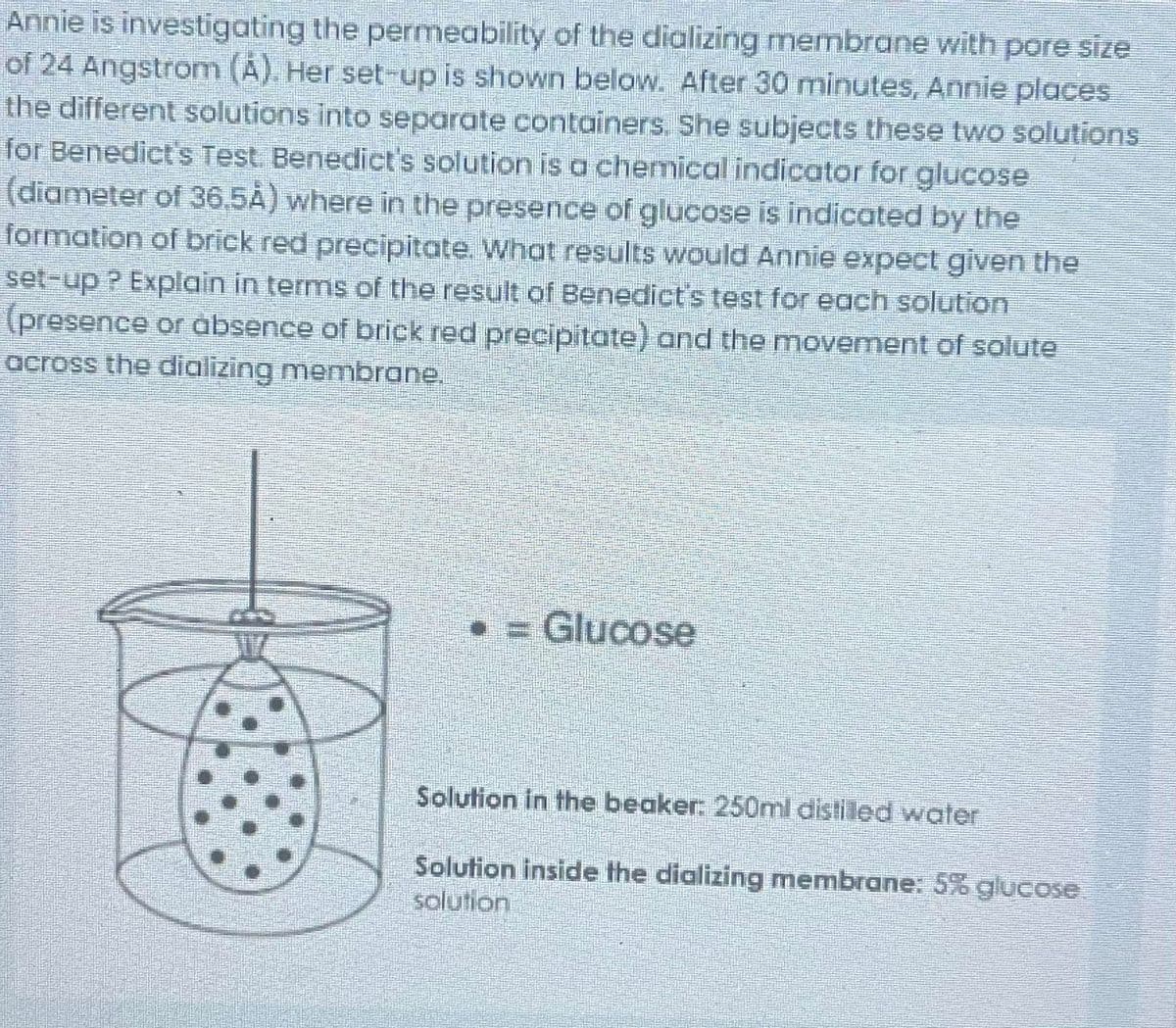Annie is investigating the permeability of the dializing membrane with pore size of 24 Angstrom (A). Her set-up is shown below. After 30 minutes, Annie places the different solutions into separate containers. She subjects these two solutions for Benedict's Test. Benedict's solution is a chemical indicator for glucose (diameter of 36,5A) where in the presence of glucose is indicated by the formation of brick red precipitate. What results would Annie expect given the set-up? Explain in terms of the result of Benedict's test for each solution (presence or absence of brick red precipitate) and the movement of solute across the dializing membrane.
Annie is investigating the permeability of the dializing membrane with pore size of 24 Angstrom (A). Her set-up is shown below. After 30 minutes, Annie places the different solutions into separate containers. She subjects these two solutions for Benedict's Test. Benedict's solution is a chemical indicator for glucose (diameter of 36,5A) where in the presence of glucose is indicated by the formation of brick red precipitate. What results would Annie expect given the set-up? Explain in terms of the result of Benedict's test for each solution (presence or absence of brick red precipitate) and the movement of solute across the dializing membrane.
Human Physiology: From Cells to Systems (MindTap Course List)
9th Edition
ISBN:9781285866932
Author:Lauralee Sherwood
Publisher:Lauralee Sherwood
Chapter3: The Plasma Membrane And Membrane Potential
Section: Chapter Questions
Problem 2SQE: One of the important uses of the Nernst equation is in describing the flow of ions across plasma...
Related questions
Question
Answer the image provided please.

Transcribed Image Text:Annie is investigating the permeability of the dializing membrane with pore size
of 24 Angstrom (A). Her set-up is shown below. After 30 minutes, Annie places
the different solutions into separate containers. She subjects these two solutions
for Benedict's Test. Benedict's solution is a chemical indicator for glucose
(diameter of 36.5A) where in the presence of glucose is indicated by the
formation of brick red precipitate. What results would Annie expect given the
set-up? Explain in terms of the result of Benedict's test for each solution
(presence or absence of brick red precipitate) and the movement of solute
across the dializing membrane.
. = Glucose
Solution in the beaker: 250ml distilled water
Solution inside the dializing membrane: 5% glucose
solution
Expert Solution
This question has been solved!
Explore an expertly crafted, step-by-step solution for a thorough understanding of key concepts.
Step by step
Solved in 2 steps

Knowledge Booster
Learn more about
Need a deep-dive on the concept behind this application? Look no further. Learn more about this topic, biology and related others by exploring similar questions and additional content below.Recommended textbooks for you

Human Physiology: From Cells to Systems (MindTap …
Biology
ISBN:
9781285866932
Author:
Lauralee Sherwood
Publisher:
Cengage Learning


Human Physiology: From Cells to Systems (MindTap …
Biology
ISBN:
9781285866932
Author:
Lauralee Sherwood
Publisher:
Cengage Learning
